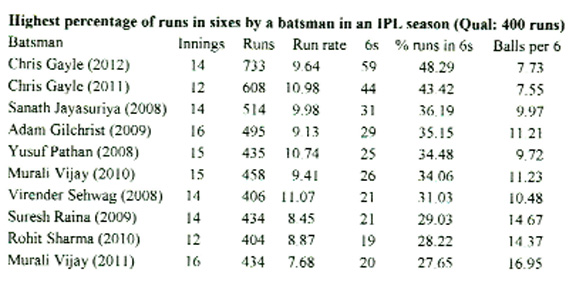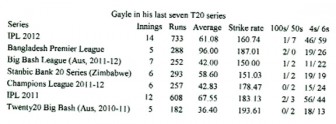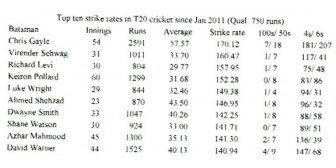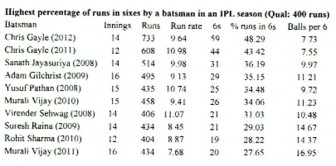Chris Gayle has scored 2591 runs in this format in the last 17 months, at an average of 57 and a strike rate of 170. No other batsman comes close
No one doubts Chris Gayle’s ability to hit the cricket ball long and hard – he has done it repeatedly in both Tests and ODIs, in all sorts of climes and conditions. Yet even his staunchest supporter will probably be amazed by the kind of numbers he has racked up in 20-over cricket. The very nature of the format demands that batsmen take risks all the time, and in doing so attempt low-percentage shots and get out. An average of 30 is considered acceptable in this version, at a strike rate of around 125.
Not for Gayle, though. The spat with the West Indies board has been terrible news for the international team, but it has given Gayle ample time to play 20-over cricket for various sides, in various conditions, all over the world. (The list reads as follows: Barisal Burners, Sydney Thunder, Matabeleland Tuskers, Royal Challengers Bangalore, Western Australia, Kolkata Knight Riders, Stanford Superstars, Jamaica and PCA Masters XI.) It has given him the opportunity to hone his skills, and work out his best strokes and scoring areas. The result has been awesome – Gayle is, quite simply, the best batsman in the world in 20-over cricket; no one even comes close.
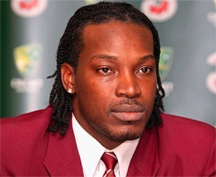
The IPL was only the latest example of what he is capable of achieving in this format – his tally of 733 was easily the highest in this edition of the tournament – and also the highest in any edition – while his 59 sixes are as many as the sum of the next three batsmen put together. His IPL performance took his tally of Twenty20 runs for 2012 past 1000, the second successive year he has achieved this. (In fact, his T20 averages in 2011 and 2012 are exactly the same – 57.57.)
Gayle’s record in the last 17 months has been especially formidable – it has helped that during this period he has played a couple of tournaments that have featured less than top-class cricket, but largely, Gayle’s stats reflect that he has worked out the format perfectly, and figured out what works best for him. In IPL 2012, for example, he usually gave himself a couple of overs to settle in – scoring only 52 from 61 balls during this period – before shifting to a higher gear in the rest of the Powerplay overs (167 runs off 118).
He then took a breather in the seventh over after the Powerplay mayhem (15 off 23) before really turning it on: from the tenth over onwards, his scoring rate was 12.43 per over (429 off 207). Despite scoring at such a frenetic pace, he was dismissed just seven times during this period.
And then there was the manner in which he scored his runs: unlike other batsmen, who tried the scoop, paddle, switch hit, reverse sweep, and all other sorts of unconventional strokes, Gayle largely stuck to conventional shots, mostly presenting the full face of the bat to the ball, and scoring most of his runs in the arc between cover and mid-on: 493 of his 733 runs, and 54 of his 59 sixes, came in that region. On the other hand, he scored only 44 runs in the third-man and fine-leg areas.
In the last seven Twenty20 series that he has played, Gayle has been remarkably consistent: he has averaged more than 58 in four, and more than 42 in two more. In all of them he has achieved a strike rate of 150 or more. In the one series in which he averaged less than 40 – 36.40 in the 2010-11 Big Bash in Australia – he compensated by scoring at a strike rate of 193.61.
A comparison with other top Twenty20 batsmen during the last 17 months shows how far ahead of the others Gayle is. Not only is his average much superior to the rest, his strike rate is also the highest among batsmen who have scored 750 or more runs during this period. Gayle’s eight hundreds overall in this format is the best too, three better than David Warner. Currently three batsmen have scored more Twenty20 runs than Gayle – David Hussey, Brad Hodge and Brendon McCullum – but a few more such IPL seasons and Gayle could well go past all of them.
During this period Gayle has struck 26 more sixes than fours; Kieron Pollard is the only other batsman to have scored more sixes than fours, but the difference in his case is only three. Gayle’s 207 sixes means he has scored 1242 runs in sixes, out of 2591 – a percentage of 47.94.
And Gayle kept up that pattern of scoring in IPL 2012 too, with 354 runs in sixes, a percentage of 48.29. In fact, his sixes make a difference of one percentage point to the overall percentage of runs in sixes in IPL 2012 – in the entire tournament, 19.43% of the total runs were scored in sixes; excluding Gayle’s stats, that percentage drops to 18.42.
With the World Twenty20 coming up later this year, West Indies could be a truly formidable force if Gayle, Dwayne Smith and Pollard joined forces – more so since they have Sunil Narine in their ranks too.
